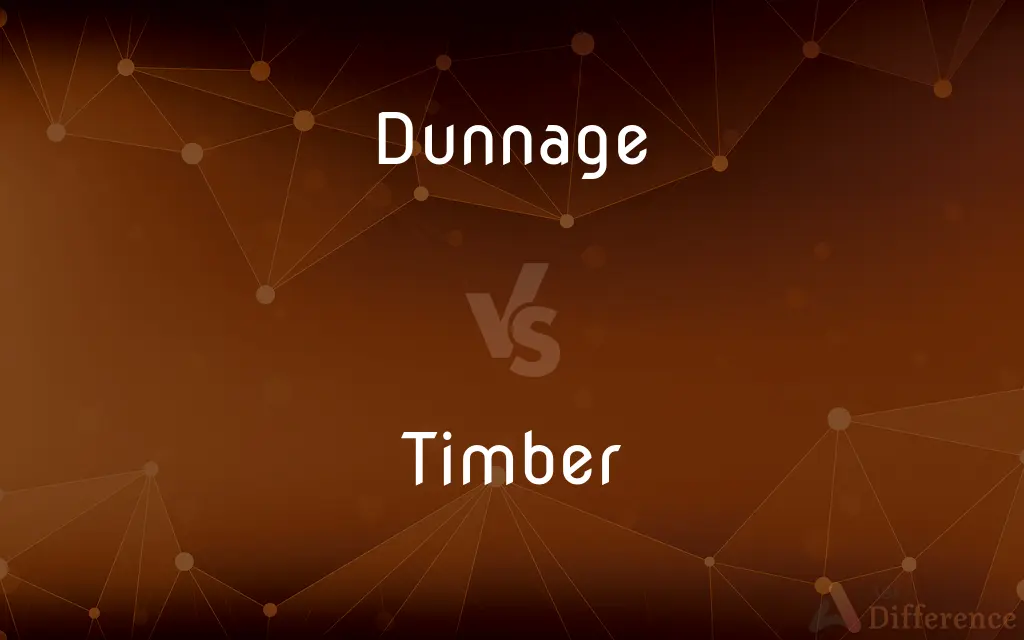Dunnage vs. Timber — What's the Difference?
By Fiza Rafique & Maham Liaqat — Updated on May 8, 2024
Dunnage refers to material used to protect and secure cargo during shipping, while timber denotes wood processed for construction and manufacturing.

Difference Between Dunnage and Timber
Table of Contents
ADVERTISEMENT
Key Differences
Dunnage is specifically used to brace and protect cargo during transportation, ensuring that items are stable and secure. On the other hand, timber refers to wood that has been processed into beams and planks, making it suitable for construction and structural purposes.
Dunnage materials can include various substances like wood, foam, plastic, or matting, tailored to cushion and restrict cargo movement. Whereas timber is primarily wood processed for use in building or carpentry, emphasizing strength and durability.
In shipping contexts, dunnage is essential for preventing damage by absorbing shocks and impacts. In contrast, timber is valued in construction for its load-bearing properties and natural aesthetic.
The selection of dunnage is often governed by its ability to be recycled or disposed of easily, reflecting environmental and economic considerations. Timber, however, is chosen based on characteristics like grain, density, and resistance to decay, crucial for its long-term performance in structures.
Regulatory standards for dunnage are centered around preventing contamination and ensuring safety in transport. Meanwhile, timber standards focus on sustainability, strength ratings, and treatment processes to ensure it meets specific building codes.
ADVERTISEMENT
Comparison Chart
Primary Use
Protecting and securing cargo in transit
Construction and structural applications
Material Types
Wood, foam, plastic, matting
Mostly wood (processed)
Key Properties
Cushioning, absorbent, lightweight
Strength, durability, aesthetic
Environmental Impact
Often disposable or recyclable
Requires sustainable sourcing
Regulatory Focus
Prevention of cargo contamination
Building safety and quality standards
Compare with Definitions
Dunnage
Primarily functional and cost-effective.
Cheap timber scraps were used as dunnage to save costs.
Timber
Sourced with sustainability in mind.
The timber used in our project was certified sustainable.
Dunnage
Material used to protect goods during shipping.
Foam dunnage was placed around the electronics to prevent movement.
Timber
Comes in various grades and sizes.
We selected high-grade timber for the flooring.
Dunnage
Aims to meet specific transportation standards.
All dunnage must be treated to prevent pest contamination.
Timber
Aesthetically pleasing and durable.
The house featured exposed timber beams for a rustic look.
Dunnage
Often lightweight and designed for single use.
The cargo hold was filled with inflatable dunnage to cushion the load.
Timber
Wood processed for construction purposes.
The cabin was built using pine timber from local forests.
Dunnage
May be composed of various materials.
Plastic dunnage bags are used to fill voids in shipping containers.
Timber
Often treated to resist decay and pests.
Treated timber is essential for outdoor structures.
Dunnage
Dunnage is inexpensive or waste material used to load and secure cargo during transportation; more loosely, it refers to miscellaneous baggage, brought along during travel. The term can also refer to low-priority cargo used to fill out transport capacity which would otherwise ship underweight.
Timber
Trees or wooded land considered as a source of wood.
Dunnage
Loose packing material used to protect a ship's cargo from damage during transport.
Timber
Wood used as a building material; lumber.
Dunnage
Personal baggage.
Timber
A dressed piece of wood, especially a beam in a structure.
Dunnage
Scrap material, often wood, used to fill spaces to prevent the shifting of more valuable items during transport, or underneath large or heavy items to raise them slightly above the ground, in order to protect from chafing and wet.
Timber
(Nautical) A rib in a ship's frame.
Dunnage
Personal effects; baggage.
Timber
A person considered to have qualities suited for a particular activity
That trainee is executive timber.
Dunnage
Fagots, boughs, or loose materials of any kind, laid on the bottom of the hold for the cargo to rest upon to prevent injury by water, or stowed among casks and other cargo to prevent their motion.
Timber
To support or frame with timbers
Timber a mine shaft.
Timber
Used by one cutting down a tree to warn those around that the tree is about to fall.
Timber
(uncountable) Trees in a forest regarded as a source of wood.
Collect timber
Cut down timber
Timber
Wood that has been pre-cut and is ready for use in construction.
Timber
(countable) A heavy wooden beam, generally a whole log that has been squared off and used to provide heavy support for something such as a roof.
The timbers of a ship
Timber
Material for any structure.
Timber
The wooden stock of a rifle or shotgun.
Timber
(archaic) A certain quantity of fur skins (as of martens, ermines, sables, etc.) packed between boards; in some cases forty skins, in others one hundred and twenty. Also timmer, timbre.
Timber
Used by loggers to warn others that a tree being felled is falling.
Timber
(transitive) To fit with timbers.
Timbering a roof
Timber
To construct, frame, build.
Timber
To light or land on a tree.
Timber
(obsolete) To make a nest.
Timber
(transitive) To surmount as a timber does.
Timber
A certain quantity of fur skins, as of martens, ermines, sables, etc., packed between boards; being in some cases forty skins, in others one hundred and twenty; - called also timmer.
Timber
The crest on a coat of arms.
Timber
That sort of wood which is proper for buildings or for tools, utensils, furniture, carriages, fences, ships, and the like; - usually said of felled trees, but sometimes of those standing. Cf. Lumber, 3.
And ta'en my fiddle to the gate, . . . And fiddled in the timber!
Timber
The body, stem, or trunk of a tree.
Timber
Fig.: Material for any structure.
Such dispositions are the very errors of human nature; and yet they are the fittest timber to make politics of.
Timber
A single piece or squared stick of wood intended for building, or already framed; collectively, the larger pieces or sticks of wood, forming the framework of a house, ship, or other structure, in distinction from the covering or boarding.
So they prepared timber . . . to build the house.
Many of the timbers were decayed.
Timber
Woods or forest; wooden land.
Timber
A rib, or a curving piece of wood, branching outward from the keel and bending upward in a vertical direction. One timber is composed of several pieces united.
Timber
To surmount as a timber does.
Timber
To furnish with timber; - chiefly used in the past participle.
His bark is stoutly timbered.
Timber
To light on a tree.
Timber
To make a nest.
Timber
The wood of trees cut and prepared for use as building material
Timber
A beam made of wood
Timber
A post made of wood
Timber
Land that is covered with trees and shrubs
Timber
(music) the distinctive property of a complex sound (a voice or noise or musical sound);
The timbre of her soprano was rich and lovely
The muffled tones of the broken bell summoned them to meet
Common Curiosities
What types of materials can be used as dunnage?
Materials like wood, foam, inflatable bags, and plastic can be used as dunnage.
What is dunnage used for?
Dunnage is used to protect and stabilize cargo during transportation.
What is timber primarily used for?
Timber is primarily used in construction and furniture making.
Is recycled material used for dunnage?
Yes, recycled materials are frequently used for dunnage to reduce waste.
How do environmental standards affect dunnage?
Environmental standards ensure dunnage materials are safe, do not contaminate cargo, and are often recyclable.
Can dunnage be made from timber?
Yes, timber can be used as dunnage when it is cut to size to support and protect cargo.
Why is the sustainability of timber important?
Sustainability is crucial to prevent deforestation and ensure a responsible supply chain.
How is timber processed?
Timber is processed by cutting, seasoning, and sometimes treating wood to enhance its durability and appearance.
What is the difference in regulatory standards between dunnage and timber?
Dunnage standards focus on safety in transit and contamination prevention, while timber standards address structural integrity and environmental impact.
What are the economic considerations for choosing dunnage?
When we discuss economic factors, we often consider the cost and disposability aspects.
Share Your Discovery

Previous Comparison
Cantoris vs. Decani
Next Comparison
Exercise vs. HomeworkAuthor Spotlight
Written by
Fiza RafiqueFiza Rafique is a skilled content writer at AskDifference.com, where she meticulously refines and enhances written pieces. Drawing from her vast editorial expertise, Fiza ensures clarity, accuracy, and precision in every article. Passionate about language, she continually seeks to elevate the quality of content for readers worldwide.
Co-written by
Maham Liaqat












































